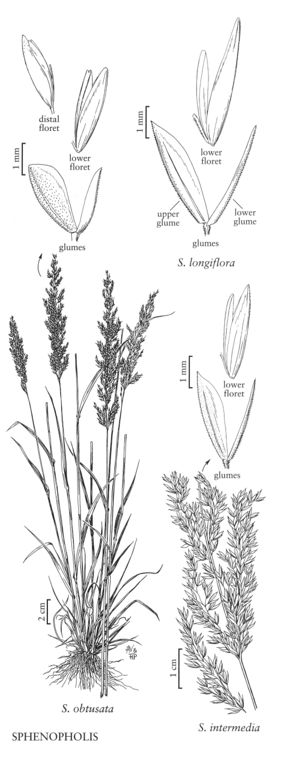Difference between revisions of "Sphenopholis obtusata"
FNA>Volume Importer |
imported>Volume Importer |
||
| (5 intermediate revisions by 2 users not shown) | |||
| Line 7: | Line 7: | ||
|synonyms={{Treatment/ID/Synonym | |synonyms={{Treatment/ID/Synonym | ||
|name=Sphenopholis obtusata var. pubescens | |name=Sphenopholis obtusata var. pubescens | ||
| − | |authority= | + | |authority= |
| + | |rank=variety | ||
}} {{Treatment/ID/Synonym | }} {{Treatment/ID/Synonym | ||
|name=Sphenopholis obtusata var. lobata | |name=Sphenopholis obtusata var. lobata | ||
| − | |authority= | + | |authority= |
| + | |rank=variety | ||
}} {{Treatment/ID/Synonym | }} {{Treatment/ID/Synonym | ||
|name=Eatonia annua | |name=Eatonia annua | ||
| − | |authority= | + | |authority= |
| + | |rank=species | ||
}} | }} | ||
|hierarchy=Poaceae;Poaceae subfam. Pooideae;Poaceae tribe Poeae;Sphenopholis;Sphenopholis obtusata | |hierarchy=Poaceae;Poaceae subfam. Pooideae;Poaceae tribe Poeae;Sphenopholis;Sphenopholis obtusata | ||
| Line 25: | Line 28: | ||
-->{{Treatment/Body | -->{{Treatment/Body | ||
| − | |distribution=Conn.;N.J.;N.Y.;Wash.;Del.;D.C;Wis.;W.Va.;Pacific Islands (Hawaii);Mass.;Maine;N.H.;R.I.;Vt.;Fla.;Wyo.;N.Mex.;Tex.;La.;Tenn.;N.C.;S.C.;Pa.;Nev.;Va.;Colo.;Miss.;Calif.;Ala.;Kans.;N.Dak.;Nebr.;Okla.;S.Dak.;Ark.;Ill.;Ga.;Ind.;Iowa;Ariz.;Idaho;Md.;Ohio;Utah;Mo.;Minn.;Mich.;Mont.;Alta.;B.C.;Man.;N.B.;Ont.;Sask.;Ky.;Oreg. | + | |distribution=Conn.;N.J.;N.Y.;Wash.;Del.;D.C.;Wis.;W.Va.;Pacific Islands (Hawaii);Mass.;Maine;N.H.;R.I.;Vt.;Fla.;Wyo.;N.Mex.;Tex.;La.;Tenn.;N.C.;S.C.;Pa.;Nev.;Va.;Colo.;Miss.;Calif.;Ala.;Kans.;N.Dak.;Nebr.;Okla.;S.Dak.;Ark.;Ill.;Ga.;Ind.;Iowa;Ariz.;Idaho;Md.;Ohio;Utah;Mo.;Minn.;Mich.;Mont.;Alta.;B.C.;Man.;N.B.;Ont.;Sask.;Ky.;Oreg. |
|discussion=<p><i>Sphenopholis obtusata</i> grows in prairies, marshes, dunes, forests, and waste places, at 0-2500 m. Its range extends from British Columbia to New Brunswick, through most of the United States, to southern Mexico and the Caribbean. The distal lemmas of <i>S. obtusata</i> are occasionally somewhat scabrous. Such plants can be distinguished from <i>S. nitida</i> (p. 621) by their narrower lower glumes, from <i>S. filiformis</i> (p. 621) by their wider leaves, and from <i>S. pensylvanica</i> (p. 621) by their shorter, unawned spikelets. Hybrids with <i>S. pensylvanica</i>, called <i>Sphenopholis</i> xpallens, have short (0.1-4 mm) awns on the distal lemmas.</p> | |discussion=<p><i>Sphenopholis obtusata</i> grows in prairies, marshes, dunes, forests, and waste places, at 0-2500 m. Its range extends from British Columbia to New Brunswick, through most of the United States, to southern Mexico and the Caribbean. The distal lemmas of <i>S. obtusata</i> are occasionally somewhat scabrous. Such plants can be distinguished from <i>S. nitida</i> (p. 621) by their narrower lower glumes, from <i>S. filiformis</i> (p. 621) by their wider leaves, and from <i>S. pensylvanica</i> (p. 621) by their shorter, unawned spikelets. Hybrids with <i>S. pensylvanica</i>, called <i>Sphenopholis</i> xpallens, have short (0.1-4 mm) awns on the distal lemmas.</p> | ||
|tables= | |tables= | ||
| Line 35: | Line 38: | ||
-->{{#Taxon: | -->{{#Taxon: | ||
name=Sphenopholis obtusata | name=Sphenopholis obtusata | ||
| − | |||
|authority=(Michx.) Scribn. | |authority=(Michx.) Scribn. | ||
|rank=species | |rank=species | ||
| Line 42: | Line 44: | ||
|basionyms= | |basionyms= | ||
|family=Poaceae | |family=Poaceae | ||
| − | |distribution=Conn.;N.J.;N.Y.;Wash.;Del.;D.C;Wis.;W.Va.;Pacific Islands (Hawaii);Mass.;Maine;N.H.;R.I.;Vt.;Fla.;Wyo.;N.Mex.;Tex.;La.;Tenn.;N.C.;S.C.;Pa.;Nev.;Va.;Colo.;Miss.;Calif.;Ala.;Kans.;N.Dak.;Nebr.;Okla.;S.Dak.;Ark.;Ill.;Ga.;Ind.;Iowa;Ariz.;Idaho;Md.;Ohio;Utah;Mo.;Minn.;Mich.;Mont.;Alta.;B.C.;Man.;N.B.;Ont.;Sask.;Ky.;Oreg. | + | |illustrator=Linda Ann Vorobik;Hana Pazdírková |
| + | |illustration copyright=Utah State University | ||
| + | |distribution=Conn.;N.J.;N.Y.;Wash.;Del.;D.C.;Wis.;W.Va.;Pacific Islands (Hawaii);Mass.;Maine;N.H.;R.I.;Vt.;Fla.;Wyo.;N.Mex.;Tex.;La.;Tenn.;N.C.;S.C.;Pa.;Nev.;Va.;Colo.;Miss.;Calif.;Ala.;Kans.;N.Dak.;Nebr.;Okla.;S.Dak.;Ark.;Ill.;Ga.;Ind.;Iowa;Ariz.;Idaho;Md.;Ohio;Utah;Mo.;Minn.;Mich.;Mont.;Alta.;B.C.;Man.;N.B.;Ont.;Sask.;Ky.;Oreg. | ||
|reference=None | |reference=None | ||
|publication title= | |publication title= | ||
|publication year= | |publication year= | ||
|special status= | |special status= | ||
| − | |source xml=https:// | + | |source xml=https://bitbucket.org/aafc-mbb/fna-data-curation/src/200273ad09963decb8fc72550212de541d86569d/coarse_grained_fna_xml/V24/V24_888.xml |
|subfamily=Poaceae subfam. Pooideae | |subfamily=Poaceae subfam. Pooideae | ||
|tribe=Poaceae tribe Poeae | |tribe=Poaceae tribe Poeae | ||
Latest revision as of 17:25, 11 May 2021
Culms (9)20-130 cm. Sheaths glabrous or hairy, sometimes scabridulous; ligules (1)1.5-2.5 mm, erose-ciliate, more or less lacerate; blades 5-14 cm long, (1)2-8 mm wide, usually flat, rarely slightly involute, scabrous or pubescent. Panicles (2)5-15(25) cm long, 0.5-2 cm wide, usually erect, often spikelike, spikelets usually densely arranged. Spikelets 2.2-3.6 mm. Lower glumes less than 1/3 as wide as the upper glumes; upper glumes 1.5-2.5 mm, subcucullate, width/length ratio 0.3-0.5, apices rounded to truncate; lowest lemmas 1.9-2.8 mm, usually scabridulous distally; distal lemmas usually smooth on the sides, occasionally scabrous, unawned; anthers 0.2-1 mm. 2n = 14.
Distribution
Conn., N.J., N.Y., Wash., Del., D.C., Wis., W.Va., Pacific Islands (Hawaii), Mass., Maine, N.H., R.I., Vt., Fla., Wyo., N.Mex., Tex., La., Tenn., N.C., S.C., Pa., Nev., Va., Colo., Miss., Calif., Ala., Kans., N.Dak., Nebr., Okla., S.Dak., Ark., Ill., Ga., Ind., Iowa, Ariz., Idaho, Md., Ohio, Utah, Mo., Minn., Mich., Mont., Alta., B.C., Man., N.B., Ont., Sask., Ky., Oreg.
Discussion
Sphenopholis obtusata grows in prairies, marshes, dunes, forests, and waste places, at 0-2500 m. Its range extends from British Columbia to New Brunswick, through most of the United States, to southern Mexico and the Caribbean. The distal lemmas of S. obtusata are occasionally somewhat scabrous. Such plants can be distinguished from S. nitida (p. 621) by their narrower lower glumes, from S. filiformis (p. 621) by their wider leaves, and from S. pensylvanica (p. 621) by their shorter, unawned spikelets. Hybrids with S. pensylvanica, called Sphenopholis xpallens, have short (0.1-4 mm) awns on the distal lemmas.
Selected References
None.
